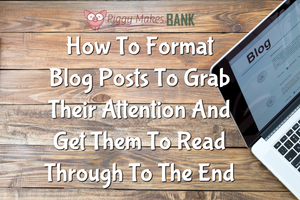We got an interesting question from one of our PLR customers on Facebook about formatting blog posts and how to learn to do this in a way that engages readers. Here’s the question:

That’s a great question and sadly there isn’t a good resource out there we could point you to. So we decided to write one up 😀
Formatting blog posts is something we do quite a bit here at Piggy Makes Bank  as well as on our niche sites and it makes a huge difference. It accomplishes so many things for you including:
as well as on our niche sites and it makes a huge difference. It accomplishes so many things for you including:
- Grabbing the reader’s attention and getting them to read the post in the first place.
- It allows your audience to quickly scan through the post to see if it’s something they want to read.
- You can highlight the most important points in the post.
- It helps with SEO (free traffic from search engines).
- It’s easier on the eyes.
- It makes reading your content on a digital device easier.
- It moves your readers right along to the end.
- You get to highlight your calls to action.
- It’s the quickest way to make PLR content stand out from the crowd and look like something you’ve created from scratch.
Do we have you convinced of the importance of formatting your blog posts yet? Let’s get into the nitty-gritty of how to do this.
How To Format Your Content
There are all sorts of different things you can do to break up chunks of text and pull out highlights including:
- Headlines and Subheadings
- Lists, both bulleted and numbered.
- bolding and italiziing
- Using a different font size, type, and color
- Highlighting text
- Adding images
Let’s assume you start with a PLR article that consists of several longish paragraphs of text. Paste it into your dashboard as a new blog post draft. Read through it and look for key points or sections. Start by adding a subheading or two. Bold a few words or key phrases that stand out to you. Is there an opportunity to turn a sentence into a list? Does it make sense to add a short list to illustrate a point or serve as an example? Look at how we used lists and subheadings in this blog post as an example.
Speaking of looking at examples… one of the best ways to learn how to do this is to study what others are doing. Tracy, who asked the original question mentioned that she’s seen this in action.
Take a closer look when you see a post that does this well, or when you find yourself drawn into reading an article. Study what formatting they are using and how they are using it.
- Do they include headlines that make you curious?
- What’s grabbing your attention there?
- Are they vague?
Maybe there’s a headline that leaves out an important part of the message like “This ended up being the secret ingredient that helped her lose those last 10 pounds”.
Maybe it’s one that focuses on results (like the mention of 10 pounds in that example).
Maybe it’s the promise of how to information like in our sub-headline in this blog post.
Study what others in your niche are doing and start applying it to what you do.
Above all, practice. There isn’t an exact formula for doing this. Start by what stands out for you.
If you’re going after search engine traffic, highlight your key phrase. Don’t overdo it though and always keep the benefit of your readers in mind first.
Write and format for your audience first and search engine bots second. Keep practicing and you’ll master this formatting skill in no time.
Was this helpful? Do you have specific questions?
